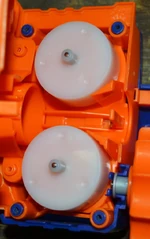
A Stockade's flywheel system.
A flywheel is a rotating plastic disc with teeth. It is a main component in flywheel powered blasters. Flywheels are most often arranged in vertical pairs inside a flywheel cage with a space in between for the darts to pass through, although they can be arranged horizontally as well.
Details
All flywheel blasters are either fully or semi-automatic, and most require batteries to use. Flywheel blasters will have either a pusher mechanism or a conveyor system to deliver the darts to the flywheel cage and thus out the barrel of the blaster. The flywheels first need to be spooled up in order for the dart to fire correctly, and so most flywheel blasters will feature an acceleration trigger or an on/off button to engage the flywheels. Having the flywheels at maximum speed is critical for obtaining the best performance. The first few flywheel powered blasters were manually powered and had to be revved up by hand in order to function.
Trivia
- The first Nerf blaster to feature a flywheel was the ripsaw.
- Some flywheels, such as those in the Barricade RV-10 and Buzzsaw, have teeth on them to give more grip when firing.
- The Ripsaw, Gyro Strike and Buzzsaw use a very simplified version of a flywheel. The flywheel is powered by hand, unlike modern flywheel blasters.
- These flywheels also do not use a conveyor or a pusher mechanism. Instead, the ammunition drops on the flywheel when the Trigger is pulled.
- The Ballzooka MP150 and Motorized Disk Launcher were the first blasters to feature an electronic version of the flywheel. Previous blasters featured hand-powered flywheels.
- Flywheel blasters typically have an inductor added into the circuit as a means to let the motors rev-up at a slower rate and a diode to prevent reverse currents. These are to comply with toy safety standards.
- The Nitron, RapidStrike CS-18, Rhino-Fire, Khaos MXVI-4000, Mega Mastodon and HyperFire are examples of flywheel blasters that are fully automatic rather than semi-automatic.
- The Nitron features a single horizontal flywheel instead of two. This is due to the fact that the Vortex discs need to spin in order to be stable and having two flywheels would not make the discs spin.
- Newer blasters such as the HyperFire and the Regulator feature a conveyor belt system which is able to feed darts to the flywheels much faster than the standard pusher mechanism.
- Accelerators, or boosters, for toy racetrack sets such as Hot Wheels use a system similar to the flywheel. Whether or not the flywheel was based off it is unknown.
| view • editBlaster anatomy | |
|---|---|
| External features | Barrel • Clip well • Cylinder • Jam door • Muzzle • Priming indicator • Priming mechanism • Safety • Sling mount • Tactical rail (RIVAL • BOOMco. • Buzz Bee • Dart Zone • X-Shot • Picatinny) • Trigger (Acceleration trigger • Firing trigger) • Turret • Unjamming button |
| Firing mechanisms | Air bladder • Air tank • Flywheel • Plunger (Direct • HAMP • Motorized direct • Reverse) • String |
| Dart delivery | Bolt sled • Breech • Conveyor system • Dart tooth • Pusher mechanism • Rotation mechanism |
| Plunger parts | Catch • O-ring • Plunger head • Plunger tube • Plunger rod • Spring (Torsion) |
| Other internals | Air restrictor (Intelligent) • Dart post • Flywheel cage • Hop-up tab • Lock |
